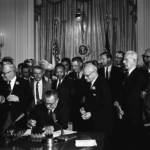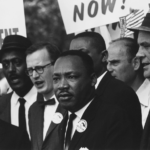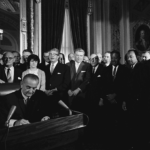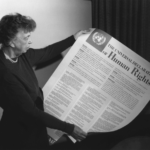While the Reconstruction Amendments were an important step in ensuring equal rights for all people, regardless of race, racial injustices throughout the United States continued into the late 19th and 20th centuries, leading to the Civil Rights movement of the 1960s, and the passages of Supreme Court decisions and legislation, including Brown v. Board of Education, the Civil Rights Act of 1964, and the Voting Rights Act of 1965. Visit the National Constitution Center’s learning module to learn more about the freedom struggle and civil rights.
Competing Voices of the Civil Rights Movement
When most people think of the Civil Rights Movement in America, they think of Martin Luther King, Jr. delivering his “I Have a Dream” speech on the steps of the Lincoln Memorial in 1963 and receiving the Nobel Peace Prize the following year. But “the Movement” achieved its greatest results — the 1964 Civil Rights Act and the 1965 Voting Rights Act — due to the competing strategies and agendas of diverse individuals. Even black Americans, the primary beneficiaries of this landmark legislation, did not agree on the tactics that should be used to secure the equal protection of their rights. This unit presents the views of several important black leaders who shaped the debate over how to achieve freedom and equality in a nation that had long denied a portion of the American citizenry the full protection of their rights.
Freedom Summer 1964
Freedom Summer is a digital learning tool (available on the web or as an app) for teachers and students that explores key events surrounding this time in America’s history and the impact of the civil rights movement on civil rights legislation. Players predict the outcomes of civil and congressional actions and discover how the events are intertwined. Students have the opportunity to view informative intro and outro videos and analyze 20 primary sources depicting images of civil rights events. Analysis of a variety of primary sources and supplemental information leads students to identify varying perspectives and potential outcomes. Freedom Summer is formatted for all types of computers and mobile devices, including Chromebooks, and can be found on the website or in any app store for download.
The 1964 Civil Rights Act: Lesson Plans and Resources

On July 2, 1964, President Lyndon B. Johnson signed the Civil Rights Act into law. Originally proposed by President Kennedy in 1963, this landmark piece of legislation made discrimination based on race, religion, sex or national origin illegal. Additionally, the Civil Rights Act ended the practice of unequal voter requirements based on race or sex and ended racial segregation in schools. The Share My Lesson team has curated a collection of free lesson plans, activities, and classroom materials for educators to use in teaching students about the Civil Rights Act.
March on Washington: Lesson Plans & Resources

On August 28, 1963, approximately 250,000 people participated in the March on Washington for Jobs and Freedom, which is considered to be one of the largest peaceful political rallies for human rights in history. Among other events, the march participants gathered at the Lincoln Memorial to hear Martin Luther King Jr. deliver his iconic “I Have a Dream” speech. Many consider The Great March on Washington to be the event that encouraged the passage of the Civil Rights Act of 1964 and the Voting Rights Act of 1965. The Share My Lesson team has created this collection of free lessons and classroom materials to help middle and high school educators teach their students about this historic event.
Voting Rights Act of 1965: Lesson Plans & Resources

On August 6, 1965, President Lyndon B. Johnson signed the Voting Rights Act into law. This landmark piece of legislation made discrimination based on race illegal. This law protected the right to vote for all citizens; forced states to obey the Constitution; and reinforced the 15th Amendment. The Share My Lesson team has curated a collection of free lesson plans, activities, and classroom materials that educators can use to teach students about the Voting Rights Act.
Teach Human Rights: Lesson Plans & Resources

The historical struggle for human rights is something that affects us, our children, and future generations as we fight for equity and inclusion in an increasingly torn society. It can also be difficult to speak with students about sensitive subjects, which is why this Share My Lesson collection provides expertly curated lesson plans, resources, and activities that define these rights, develop a global awareness, and teach how we can all make a difference when we act together.
The Civil Rights Movement
Clarence Taylor, historian at Baruch University, discusses the Civil Rights Movement from Brown v. Board of Education to the passage of the 1965 Voting Rights Act.
Our Rights
The book Our Rights, written by David J. Bodenhamer, uses historical case studies to explore the rights in the Constitution. Supreme Court cases are used to demonstrate how a right received its modern interpretation, how the right applies today, and how courts and other interpreters seek to balance this right with important societal concerns such as public safety. The complete book or individual chapters can be downloaded.
Title IX
Title IX of the Education Amendments Act of 1972 prohibited discrimination on the basis of sex in educational settings. The law applied to any educational institution that received federal funding. This lesson has students learn about what Title IX does and explore its impact on gender equality today.